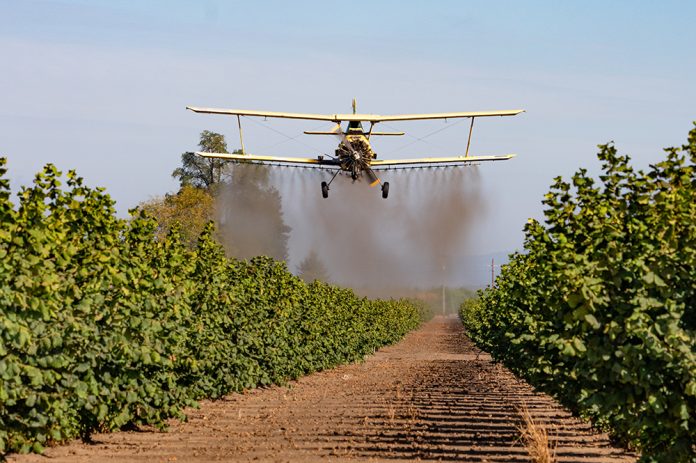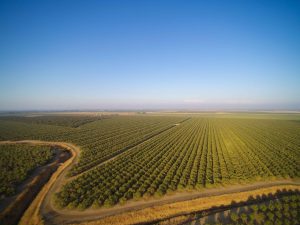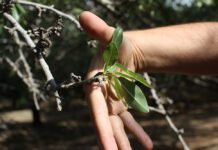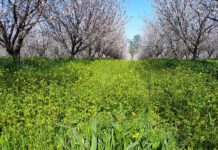
Aerial application of foliar nutrients in an orchard can be an effective method to achieve the desired plant uptake in a small window of time.
“We are not just spraying material on the trees; we want to make sure it gets into the plant,” CCA Rich Kreps said. Aerial applications of foliar nutrients have been done for decades, he said, and the application technology has improved; however, regulations, adverse weather conditions and miscommunication between crop consultants and pilots can throw a monkey wrench into the best application plans.
Determining the nutrients needed by the trees to reach production potential, calculating the application rate and complying with regulations requires knowledge of tree nutrition demands and uptake, communication, applicator skills and equipment that can do the job.
Doug Thiel, founder of Thiel Air Care in Chowchilla, Calif., said ag aviation technology has been around for the past 15 to 20 years and has given applicators the ability to make precision and variable rate applications of foliar nutrients. In fixed wing aircraft, flow controls are accurate within a tenth of a gallon, he said. Flow rates, swath widths and acres per minute are all calculations that can be made to ensure good plant coverage. Global positioning systems show the exact track of the application.
In a presentation at the California Association of Pest Control Advisors annual meeting, Thiel noted modern aircraft can deliver foliar nutrients at the desired rates and swath width while preventing drift. “We can’t afford to simply pump water anymore. We are better than that in this day and age.”
Each application has its own mission, he said. Drip control, coverage and efficacy are some desired outcomes. Different amounts of water and different droplet sizes make each application unique. It is important, he stressed, that pilots, growers and PCAs communicate their needs.
Thiel said calculation of the application rate is needed to comply with regulations and achieve the desired nutrient concentration on the leaves without causing damage. Aerial applications can also increase the nutrient concentration in droplets, offering improved uptake by the leaves.

Correct Calibration
Paul Leonardo, PCA with Simplot, said a correctly calibrated aerial application of foliar nutrients can deliver a higher concentration of the nutrients per droplet than ground delivery.
“That is the goal of a foliar application, to get the nutrients into the plant.”
Kreps said application type depends on the nutrient and the mix. Getting the pH right will allow more penetration into the leaves. The objective is for maximum absorption into the plant tissue with minimum damage to the plant tissue.
Nutrient Concentration
Leonardo explained aircraft delivery can put out 10 times the nutrient concentration in each droplet.
Type of foliar nutrient and timing of application depends on many factors including soil type, water source and variety. Leonardo said foliar applications can be an efficient way to get nutrients into a plant, but the key is the nutrient concentration in each droplet. For leaves or buds to take up the nutrient, the droplet must contain a higher concentration of the nutrient than the leaf.
Aircraft speed is the dominant factor in determining spray droplet size because the high-speed air around the plane shears the liquid as it leaves the nozzles. Droplet size affects plant coverage. At equal volume, halving the droplet diameter creates eight times as many droplets. Quartering creates 64 times as many droplets. The smaller the diameter, the greater number of droplets and less control an applicator has over where they land.
Minimizing fine droplets limits drift offsite. In addition to the increased concentration of the nutrient in each droplet, air delivery can ensure good coverage throughout the tree canopy.
“We look at what we are trying to accomplish. For example, applying a foliar nutrient in the fall on almond trees can be done to load nutrients the tree needs for a good bloom. Bloom is a high need time and trees need the stored energy through bloom for pollen tube development and fertilization that will hold more nuts on the tree. Bloom time is another common time for foliar nutrient applications, Leonardo said.
Today’s modern aircraft and a skilled pilot ensure the material is landing where it is needed.
“The planes used for aerial applications have the equipment necessary to provide excellent coverage at a fast rate. One plane can cover about 1500 acres in a day compared to maybe 50 with a ground rig,” Leonardo said. This is important, he added, when there is a small window for the application.
Weather a Factor
The National Agricultural Aviation Association states aerial applications must deposit the same amount of the product across the orchard or field. Spray booms and nozzles are mounted to account for how propellers and nozzles push air around the aircraft and direct liquid flow from each nozzle. Aircraft wings create a wake of air that pushes spray down and away, allowing the spray boom to cover an area wider than its length. Applications are made in trapezoidal patterns so each pass partially overlaps to ensure even coverage across the orchard. Calibration determines the exact swath width and overlap needed for even distribution.
Weather conditions dictate if foliar applications can be made as scheduled or if they must be postponed. Calm winds, low humidity and clear weather are favorable for aerial applications. Temperatures above 85 degrees F or windy conditions can increase risk of drift and product evaporation. Depending on the application, buffer zones around dwellings must be observed.
Kreps said for an application to work, communication is important. “You want to have someone helping the crew mix the application, to monitor and to answer any questions. The technology is there to do good applications, but it has to be done according to the recommendation.”

Cecilia Parsons | Associate Editor
Cecilia Parsons has lived in the Central Valley community of Ducor since 1976, covering agriculture for numerous agricultural publications over the years. She has found and nurtured many wonderful and helpful contacts in the ag community, including the UCCE advisors, allowing for news coverage that focuses on the basics of food production.
She is always on the search for new ag topics that can help growers and processors in the San Joaquin Valley improve their bottom line.
In her free time, Cecilia rides her horse, Holly in ranch versatility shows and raises registered Shetland sheep which she exhibits at county and state fairs during the summer.















